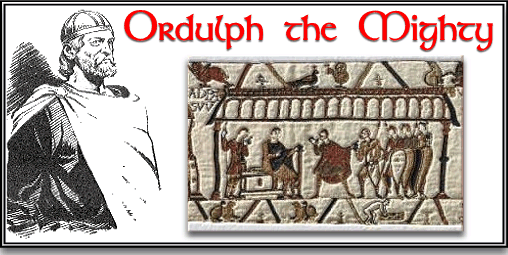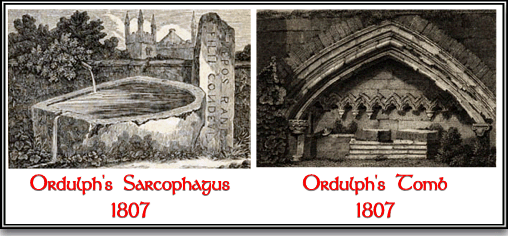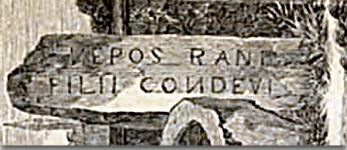
Back in the times when Dartmoor was under the rule of the dreaded Saxon’s lived a mighty man called Ordulph. His feats of legendary strength were celebrated in the mead halls by the bards. One such tale was how Ordulph would often stand astride the river Tavy and order his men to drive down all the beasts of the forest to where he stood, one foot firmly plated on each bank of the river. As the animals fled past him he would slice of their heads with one mighty swing of his knife. The weavers of stories also told of the day he accompanied King Edward on a journey to Exeter. When the King and Ordulph arrived at the city gates they found, much to Ordulph’s consternation, that the huge gates were firmly closed. The travellers demanded immediate entry but after a short wait Ordulph decided that the gates were not being opened fast enough and so with his bare hands he tore away the bars of the portcullis. Having gained access to the main gate he then proceeded to kick open the solid wooden doors, he struck the gates with such force that the bolts and locks were sent flying across the city. Having opened the doors the giant then broke down a large section of the city walls over which he and the King strode into Exeter, much to the alarm of the inhabitants.
Many people who knew Ordulph, including King Edward, were of the opinion that to be able to summon such strength only meant it came from unnatural powers. These powers were said to have come from the Devil in return for a diabolical pact made between Ordulph and the Prince of Darkness.
But there is one famous story which shows that Ordulph was far from being an evil man, in fact the story goes that it was he who founded Tavistock Abbey. According to legend, an old chartulary printed in the Monasticon, and Mrs Bray, Ordulph received a vision whilst saying his nightly prayers. He noticed a brilliant white pillar of light beaming down from the heavens and it filled him with fear. Later that same night he had a dream where an angel visited him and instructed him to find the place where the pillar of light struck the earth, here he would see four rods marking a square of earth. On this piece of land he must build a chapel and dedicate it to the four evangelists. Depending which mead hall you sit in, Ordulph either built the chapel immediately or he had to have several more visions before being sufficiently inspired to do so. Either way, not only did he build the chapel but he also built an abbey for good measure.
Ordulph appears in the Domesday Book as owning 22 manors, 19 in Devon, 2 in Cornwall and 1 in Somerset, he was described as a man of great strength and stature. His passion was hunting and it is said that his favourite hunting grounds were at Horton in East Dorset where he gave some benefactions to a recently founded abbey. Ordulph was so fond of this place that he expressed the wish for his mortal remains to be buried at the abbey. However, it is supposed that he actually died whilst out hunting on Dartmoor and once his remains were found the monks of Tavistock Abbey interred them alongside his ancestors in the abbey. Those of a cynical nature may belief that this was due to the fact that his manor of Anthony in Cornwall was pledged as a ‘souls scot’ and became a gift to the church where he was buried. It is Ordulph and his death on Dartmoor that is associated with the fabled story of Childe the Hunter. His grave was said to have been a ‘wonder’ and the parish church at Tavistock housed what was supposed to be the mighty Saxon’s thighbone.
Below are two etchings from 1807, one depicts Ordulph’s sarcophagus and the other Ordulph’s tomb, both in the ruins of Tavistock Abbey.

What does interest me is the incised stone standing to the right of the trough/sarcophagus in the etching, the stone pillar appears to have lost its tip but the writing seems to read: “VEPOS RANI FILII COИDEVI.”

However an entry on the Celtic Inscribed stones mentions a stone that now stands in the vicarage garden which reads, “NEPRANI FILI CONBEVI,” or “NEPRANI FILI CONBEVI,” which in translation reads, “(the stone of) Nepranus, son of Conbevus. It is thought that Neprani is a male Latin name and that Conbevi could be a Celtic male name originating from nearby Cornwall. I would imagine that these two stones are one and the same and that the artist was none too careful with his detail. There are various estimates of the age of the stone all of which fall between 500 and 699AD. This would then pre-date Ordulph by about two hundred and eighty odd years and so clearly has nothing to do with his sarcophagus. A good illustration of how careful you have to be when dealing with artistic interpretation.
During the building of what is now the Bedford Hotel an ancient sarcophagus was discovered and in it was two thigh bones of unusual length. These were taken to be those of the Mighty Ordulph who it appears had been buried in what was the original abbey cloisters. A stone effigy of the Saxon was also discovered and laid infront of the ruined cloister arch, from that time on local tradition called the arch, Ordulph’s tomb or Childe’s Tomb.
It is generally considered that Ordulph I, (Ordulph’s grandfather) founded the abbey around AD974 which tends to question the story of the holy vision. In AD974 it is known that Ordulph held the bailiwick of Lifton which included Tavistock. In AD981 the abbey received its first charter from the King Ethelred and conferred the title of ‘book land’ and the town, this was in effect the completion of the abbey by Ordulph.
Many thanks to Su for bringing my attention to this story and for kindly passing on the story.
 Legendary Dartmoor The many aspects past and present of Dartmoor
Legendary Dartmoor The many aspects past and present of Dartmoor
